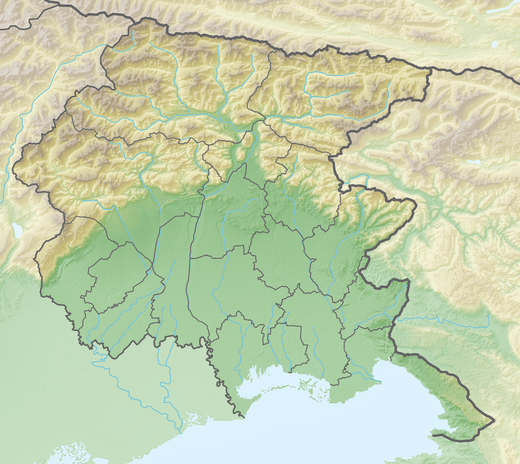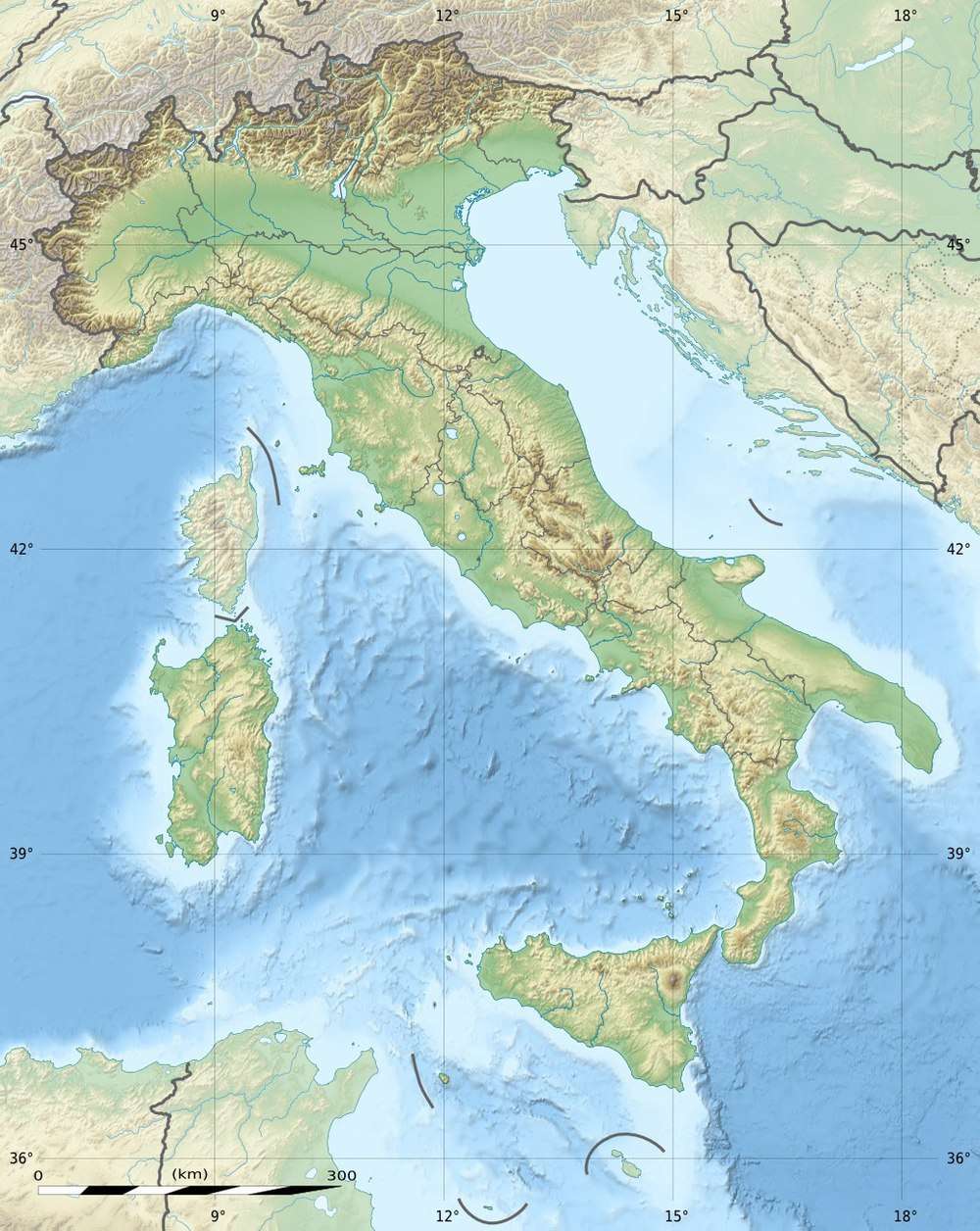Vittoria Light
Vittoria Light (Italian: Faro della Vittoria) also known as the Victory Lighthouse, is an active lighthouse in Trieste, Italy, serving the Gulf of Trieste. It is located on the hill of Gretta (Poggio di Gretta), off the Strada del Friuli. At a height of 223 feet (68 m) it is one of the tallest lighthouses in the world.[6]
 Vittoria Light in 2005 | |
 Vittoria Friuli-Venezia Giulia  Vittoria Vittoria (Italy) | |

| |
| Location | Trieste Friuli-Venezia Giulia Italy |
|---|---|
| Coordinates | 45°40′32″N 13°45′25″E |
| Year first constructed | 1927 |
| Foundation | earthwork[1] |
| Construction | stone tower |
| Tower shape | tapered cylindrical tower, crowned by a bronze statue |
| Markings / pattern | white tower, bronze figure |
| Tower height | 67.85 metres (222.6 ft)[2] |
| Focal height | 115 metres (377 ft)[3] |
| Original lens | Fresnel lens[1] |
| Light source | mains power |
| Intensity | 1,250,000 cd |
| Range | main: 22 nautical miles (41 km; 25 mi) reserve: 18 nautical miles (33 km; 21 mi)[4] |
| Characteristic | Fl 8"9 W 10s. |
| Admiralty number | E2558 |
| NGA number | 113-11676 |
| ARLHS number | ITA-174 |
| Italy number | 4376 E.F. |
| Managing agent | Marina Militare[5] |
History
The idea to raise a monument in the vicinity arose during World War I, following capture of Kobarid in the Battles of the Isonzo and following the Battle of the Piave River. Originally the lighthouse was to rise on the coast of Istria, near Pula.[7] However, the location eventually chosen was the hill of Gretta, due to ideal height (60m above sea-level) and the solid foundations of the former Austrian fort Kressich, built between 1854 and 1857. The lighthouse plans took shape following the end of the war, in December 1918. It was designed by Triestine architect Arduino Berlam. One of the reasons for building such a high monument was the desire to build a victory monument higher than the Berlin Victory Column, which was 62.3 metres (204 ft) high at the time.[7]
Work started only in 1923 and ended on May 24, 1927 with the inauguration in the presence of King Vittorio Emanuele III.[1]
The structure celebrates the Italian victory and commemorates the fallen of the first world war, as testified by the inscription "SPLENDI E RICORDA I CADUTI SUL MARE MCMXV-MCMXVIII" (shine and remind of the fallen on sea 1915-1918).[1]
In 1979 the lighthouse was closed for restoration for seven years, and was reopened to the public May 18, 1986.[8]
Structure
The large base of the lighthouse includes the earthwork of the Austrian fort. The bottom of structure is covered by stone from Carso (specifically from Gabrie) and the top is covered by stone from Istria (specifically from Vrsar). It weighs about 8,000 tonnes (7,900 long tons; 8,800 short tons) and construction involved the use of 1,500 cubic metres (53,000 cu ft) of stone (or 1,300 cubic metres (46,000 cu ft)[1]), 2,000 cubic metres (71,000 cu ft) of concrete and 100 tonnes (98 long tons; 110 short tons) of iron.[8]
Above the column is a capital and a crow's nest, in which the bronze crystal cage of the lantern is inserted. The cage is topped by a copper fome with a scale-like motif, on top of which is the 7.2 metres (24 ft) statue of winged victory by sculptor Giovanni Mayer, made of embossed copper and weighing about 7 tonnes (6.9 long tons; 7.7 short tons).[8]
A 8.6 metres (28 ft) statue of a seaman, also by sculptor Giovanni Mayer, adorns the front of the lighthouse, made from 100 tonnes (98 long tons; 110 short tons) of stone from Vrsar, under which is the anchor of the destroyer Audace, the first Italian ship to enter the port of Trieste on November 3, 1918, is attached. Two projectiles of the Austrian battleship SMS Viribus Unitis are placed on both sides of the lighthouse entry.
The light itself is an electrical light since its first lighting. The current light is a 1000 watt halogen bulb.[7]
Visiting
The site of the lighthouse is open to the public. The lighthouse itself is open Saturday and Sunday 3 pm to 7 pm, from the last Saturday of April to the second Sunday of October.[8] Reaching the top requires climbing 285 steps.[7]
See also
- List of tallest lighthouses in the world
- List of lighthouses in Italy
Notes
- "Victory lighthouse - Trieste". qsl.net. Retrieved 9 August 2010.
- According to "Provincia di Trieste". "Victory lighthouse - Trieste" and "Spifferi di Trieste" have 68.85 m. List of Lights has 223 feet (68 m).
- According to "Provincia di Trieste". "Victory lighthouse - Trieste" has 116m. List of Lights has 378 feet (115 m).
- "Faro della Vittoria". Marina Militare. Retrieved 24 April 2018.
- Rowlett, Russ. "Lighthouses of Eastern Italy". The Lighthouse Directory. University of North Carolina at Chapel Hill. Retrieved February 29, 2016.
- Rowlett, Russ. "The Tallest Lighthouses". The Lighthouse Directory. University of North Carolina at Chapel Hill.
- "Spifferi di Trieste: I record del dongiovanni allampanato" [Notes of Trieste: The records of the lanky playboy]. spifferiditrieste.blogspot.com (in Italian). Retrieved 9 August 2010.
- "Faro della Vittoria - Provincia di Trieste". provincia.trieste.it (in Italian). Retrieved 9 August 2010.
References
- List of Lights, Pub. 113: The West Coasts of Europe and Africa, the Mediterranean Sea, Black Sea and Azovskoye More (Sea of Azov) (PDF). List of Lights. United States National Geospatial-Intelligence Agency. 2009. p. 201.
- Rowlett, Russ. "Lighthouses of Eastern Italy". The Lighthouse Directory. University of North Carolina at Chapel Hill.
External links
| Wikimedia Commons has media related to Victory Lighthouse. |
- Official website
- Servizio Fari Marina Militare (in Italian)
